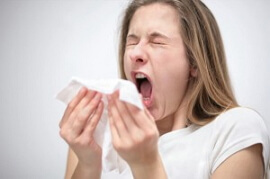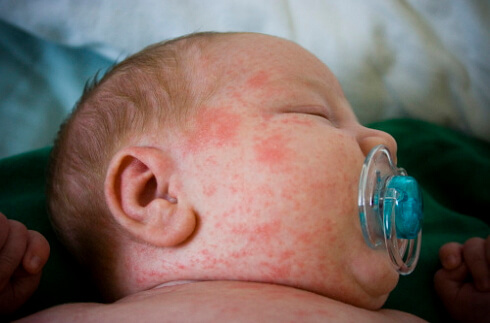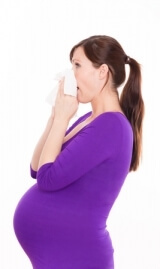Allergic rhinitis
 Allergic rhinitis( allergic rhinitis) - perhaps the most common disease with which people seek help from an allergist. This article will contain the most complete information about the symptoms, diagnosis and treatment of allergic rhinitis.
Allergic rhinitis( allergic rhinitis) - perhaps the most common disease with which people seek help from an allergist. This article will contain the most complete information about the symptoms, diagnosis and treatment of allergic rhinitis.
Allergic rhinitis is an inflammatory lesion of the mucous membranes of the nose that arises from an allergic reaction.
Typically, allergic rhinitis or coryza manifested rhinorrhea( nasal secretion actively allocated watery), sneezing, nasal obstruction and itching sensation of breathing in the nasal cavity.
According to the statistical data on this disease, allergic rhinitis affects one in five residents of Russia
Causes allergic rhinitis
The basis of this disease is the development of immediate-type hypersensitivity, and if more simply, the allergic reaction.
Allergic reaction means most allergic processes of the immediate type, the symptoms of which develops from a few seconds to twenty minutes from the initial contact with the allergen.
Allergic rhinitis along with allergic bronchial asthma and atopic dermatitis is included in the "big three" of the major allergic diseases.
Possible allergens capable of causing the development of allergic rhinitis: library or house dust;Ticks in the house dust;Pollen of plants;Insect allergens;Some food;Allergens of yeast and mold fungi.
a serious risk factor for the disease is a genetic predisposition
Symptoms of allergic rhinitis
most typical signs and symptoms of allergic rhinitis:
• Clear, watery nasal discharge, which in the case of joining a secondary infection transformed into paroxysmal frequent prolonged sneezing
• Difficulty in nasal breathing( usuallyWith a severe form of allergic rhinitis), with nasal congestion usually worse at night
• Strengthny itching in the nose
During exacerbation of allergic rhinitis is characterized by the appearance of the patient is sufficient. Owing to the difficulty of nasal breathing, the patient breathes mainly with the mouth, slight swelling of the face is observed, the eyes are often red, lacrimation is present, dark circles can appear under the eyes. Quite often and involuntarily patients with allergic rhinitis rub their nose with the palm of their hand( this symptom is called "allergic salute").
Most often, allergic rhinitis manifests itself first time in childhood or early adolescence, and among blood relatives of the patient with allergic rhinitis, people with various allergic diseases are often observed.
Allergic rhinitis, depending on the severity of symptoms classified into light, medium and heavy.
Mild severity - the symptoms of allergic rhinitis do not interfere with sleep and do not reduce efficiency. The average severity - sleep and daytime activity is reduced moderately. A severe degree of allergic rhinitis is a strong violation of sleep and performance due to the severity of the symptoms.
In terms of the length of symptoms, year-round and seasonal allergic rhinitis is isolated.
Usually seasonal allergic rhinitis occurs as a result of pollen allergy and is less common as an allergy to spores of mold fungi.
Often, when visiting a doctor, patients themselves point to allergic rhinitis-provoking factors( cleaning in an apartment, contact with animals, departure to nature, being in a dusty room, etc.).
Trial relief of antihistamines is often accompanied by temporary relief. Often the manifestations of an allergic rhinitis are combined with the symptoms of allergic conjunctivitis, or precede bronchial asthma.
Virtually all known rhinitis( occupational rhinitis, atrophic rhinitis, psychogenic rhinitis, drug-induced rhinitis, hormonal rhinitis, infectious rhinitis), except for minor differences have similar symptoms, but in spite of this, each of them requires an individual treatment. That is why correctly diagnose the disease can only specialist in this field, i.e.allergist.
Often, patients take nasal vasoconstrictor drugs for a long time, but over time, with the abuse of these medicines, the course of the disease only worsens.
Most people with allergic rhinitis experience increased sensitivity to such sharp smells as the smell of tobacco and household chemical products
. Analgeses for suspected allergic rhinitis.
. In case of the slightest suspicion of allergic rhinitis, it is necessary not to delay visiting an ENT doctor and an allergist. The otolaryngologist will be able to identify the possible presence of concomitant pathology of the ENT organs, and the allergist will exclude or vice versa confirm the allergic nature of the patient's delivery of severe inconveniences of manifestations. The most important question in the formulation of the correct diagnosis of allergic rhinitis is the identification of a causative allergen, a substance whose contact leads to the development of the above symptoms. For this, the following diagnostic types are usually used:
• Skin tests .This is perhaps the most economical and informative method for diagnosing allergies, which should always be carried out only in specially equipped honey. Office. During the examination, the patient is often on the inner surface of the forearm doing several scratches, which are applied to 1 drop of the tested allergen, after which the reaction time is estimated after the due time. This method is the most reliable and informative, but it has some limitations( skin tests are forbidden during the period of exacerbation of the disease, as well as breastfeeding and pregnant women).
At least five days before the procedure, all antihistamines taken before are canceled.
• Blood test for specific immunoglobulins .This method will detect allergens by blood analysis, and is more convenient than skin tests in that it can be taken during an exacerbation, during pregnancy, feeding a child, and against the background of taking antihistamines. Also, there are no age limits, while skin tests do not take up to one year. Despite all the above advantages, this blood test has two rather serious and sometimes decisive disadvantages - a high frequency of false positive results( about 20%) and a very high cost( $ 10 for one allergen, and sometimes they are tested up to50). Often in children under one year, a blood test revealed an allergy to exotic fruits and seafood( mussels, shrimps, crabs), while parents swore that the child had not even seen them. That is why , if the general condition allows, it is still better to be examined by staging skin tests.
Sometimes, in case of any doubt, the doctor can prescribe additional tests( smear from the nose to the fungus and microflora, x-ray of the sinuses of the nose).
Very rarely to determine the degree of violation of airway patency, the anterior rhinomanometry
is performed. Treatment of allergic rhinitis
Allergic rhinitis treatment can be started only after the final determination of its allergic nature and confirmation of the nature of the disease. Like most other allergic diseases, the treatment of allergic rhinitis is to reduce allergic inflammation of the mucosa and conduct allergen-specific therapy( immunotherapy)
Immunotherapy for allergic rhinitis
Immunotherapy is the most radical and effective treatment for allergic rhinitis. It should be noted that this treatment can only be carried out by an allergist in an allergic room or in a hospital. The tactics of this treatment consists in the introduction of small doses of a reaction-provoking allergen with a gradual increase in its concentration. The purpose of these manipulations is the development of tolerance( tolerance) in the body to allergens. In the case of proper administration of this treatment, allergic rhinitis may disappear forever. As early as possible the initiation of immunotherapy significantly increases the chance of absolute resistance to allergens and so the result, the complete cure of the disease. In a large number of patients, this method completely cured allergic rhinitis
Anti-inflammatory treatment of allergic rhinitis
This method of treatment of allergic rhinitis provides for the integrated use of a number of medications. Most often, the treatment of an allergic rhinitis begins with the appointment of antihistamines in the form of drops or tablets. In recent years, preference has been given to the second( Kestin, Zodak, Claritin, Cetrin) and the third( Zirtek, Telfast, Erius) generations, which are administered only once a day inward, at the appropriate dosage age. The duration of treatment is purely individual, but usually it lasts no more than two weeks. Despite the over-the-counter release of these drugs in the pharmacy network, they can not be prescribed for themselves for a long time, as some of these drugs negatively affect the cardiac muscle, while others noticeably inhibit the ability of the mind. The drugs of the third generation are the most safe, however their high enough cost is often the main limiting factor for many patients, especially when long-term treatment is necessary.
In the event that the above-described treatment measures have proved ineffective, local agents directly affecting the nasal mucosa are additionally assigned. At an easy degree of an allergic rhinitis appoint derivatives kromoglikat sodium( Kromosol, Kromoglin, Kromogeksal), issued in the form of nasal sprays. Drugs should be used during the entire period of exacerbation 3 r. Per day for 1 injection. The therapeutic effect of using these sprays appears not earlier than in five days( maybe later), therefore their action is considered more preventive than curative.
Usually, this group of drugs is prescribed for the treatment of allergic rhinitis in children or mild rhinitis in adults. As a rule, the course of treatment of allergic rhinitis is not less than two to four months, although all-the-year-round use of drugs is possible.
I want to pay special attention to a fairly new drug, NAZAVAL, which is based on plant cellulose. This drug is available as a nasal spray and creates a microfilm on the nasal mucosa, which prevents contacting the mucous membranes with the allergen.
In the period of exacerbation of allergic rhinitis, this spray is practically ineffective, therefore it is recommended for use only as prevention of the disease.
In severe allergic rhinitis, the main drugs of choice are sprayed nasal corticosteroids( Benorin, Nazarel, Fliksonase, Nazonex, Baconase, Nasobek, Aldetsin).Preparations are prescribed in the dosages corresponding to the current age of 1-2 r. Per day, while the duration of treatment is determined exclusively by the attending physician.
Often a possible error in the treatment of allergic rhinitis is a long-term use to facilitate the breathing of vasoconstrictive drops( Vibrocil, Naphthysine, etc.).Prolonged use of these drugs always leads to the development of medical rhinitis of any degree of severity, for the treatment of which surgical intervention on the nasal passages may be required. It is advisable to use vasoconstrictors before using intranasal glucocorticoids and only in case of severe nasal congestion.
And as a whole, it is better not to abuse the vasoconstrictor for nose for allergic rhinitis
Folk treatment of allergic rhinitis
Allergic rhinitis is one of those few diseases in which traditional medicine can not help. To date, no one has developed a working technique that could be recommended for patients with allergic rhinitis. Therefore, the treatment of allergic rhinitis using traditional medicine can lead to the attachment of a secondary infection, exacerbation of the disease and the delay in the appointment of adequate medication.
The only thing that can be recommended for patients with rhinitis, is twice a day to rinse the nose with salt r-rum( for 200 ml of water 1.5 ts. Of salt).However, even this method must necessarily be combined with medication, as when applied alone, it will not give any visible results
Lifestyle and nutrition in case of allergic rhinitis
The main aspect of treating allergic rhinitis is the elimination or reduction of contact with the allergen-provoking disease. Individual recommendations are made for each patient after identifying the causative allergen. The nature of preventive measures directly depends on the type of certain allergen.
So, during the exacerbation of pollen allergies, patients are advised to change their place of residence to an area where causative plants do not grow, and if impossible, try to leave the premises only after dinner, when the pollen concentration in the air is declining. Food allergies involve the complete exclusion of products for which the patient has had positive tests( allergy test).Allergy to dust provides for permanent wet cleaning of the room during which to prevent the ingress of dust allergens to mucous should wear a special mask
Allergic rhinitis in pregnancy
Every third woman's pregnancy contributes to the first appearance or worsening of existing allergic diseases. As for the patients themselves, and for their doctors, this presents certain difficulties, since during pregnancy most methods of examination and drugs are strictly forbidden to apply.
Symptoms of allergic rhinitis in pregnant women are absolutely no different from classical manifestations. A definite effect on the fetus can have an illness only in case of severe forms of the disease and with inadequate treatment.
The causes of allergy during pregnancy are identified, based only on the results of a blood test, as carrying out skin tests in this condition is contraindicated.
Treatment of allergic rhinitis in pregnancy is conducted with the maximum possible restriction of the use of antihistamines, because of their potentially negative effects on the fetus. In case of emergency, third-generation drugs( Telfast, etc.) are used in minimum dosages. Nasal corticosteroids should not be prescribed in the first trimester of pregnancy. For topical treatment of allergic rhinitis derivatives sodium cromoglycate used( kromogeksal, etc.) And Nazaval( agent based on cellulose)
Allergic rhinitis in children
Children allergic rhinitis usually manifests after three years, and often the child just allergic rhinitis developsin the event that in the past he has observed any allergic manifestations( usually in the form of allergic or atopic dermatitis).
A similar change in clinical allergic manifestations: atopic dermatitis → allergic rhinitis → bronchial asthma, is called an "atopic march".
Symptoms of allergic rhinitis in a child are almost identical to those observed in adults, with only one difference: children experience a somewhat greater sensitization to food allergens.
Treatment of allergic rhinitis in children begins with the selection of the most optimal drugs that have the largest possible safety profile. However, at an early age, the greatest positive effect is provided by immunotherapy.
forecast of allergic rhinitis is quite favorable, but in the absence of adequate treatment, the disease can begin to progress, as would indicate a large severity of symptoms( headache, nasal bleeding, deterioration odor recognition, cough, sore throat, irritation of the skin on the wings of the nose and / orAnd over the upper lip), as well as the expansion of the spectrum of causative allergens.
Today, as such, the prevention of allergic rhinitis has not yet been developed. In the case of already developed allergies, all preventive measures is to eliminate contact with the allergen provoking and carrying out adequate timely treatment.



